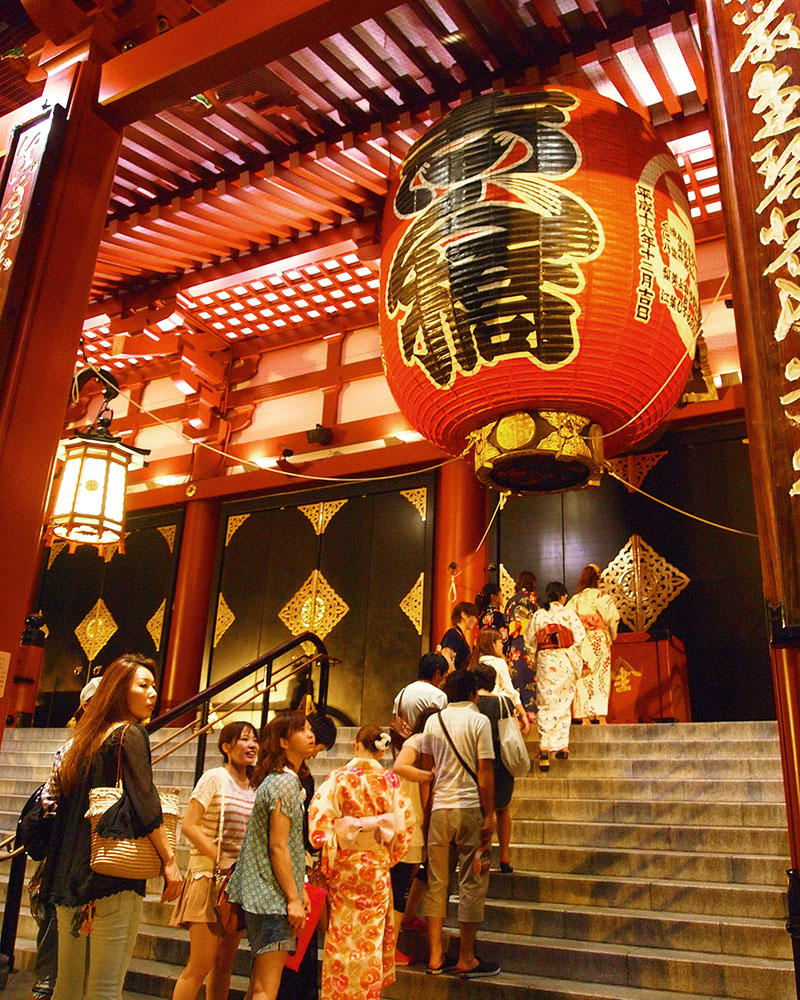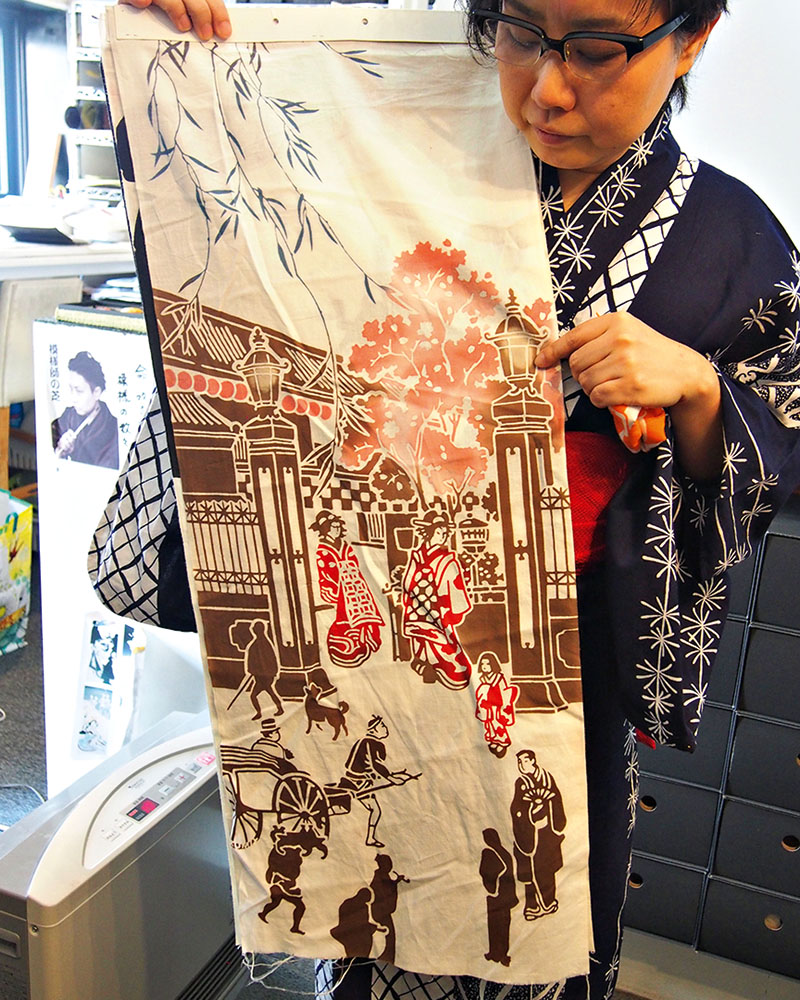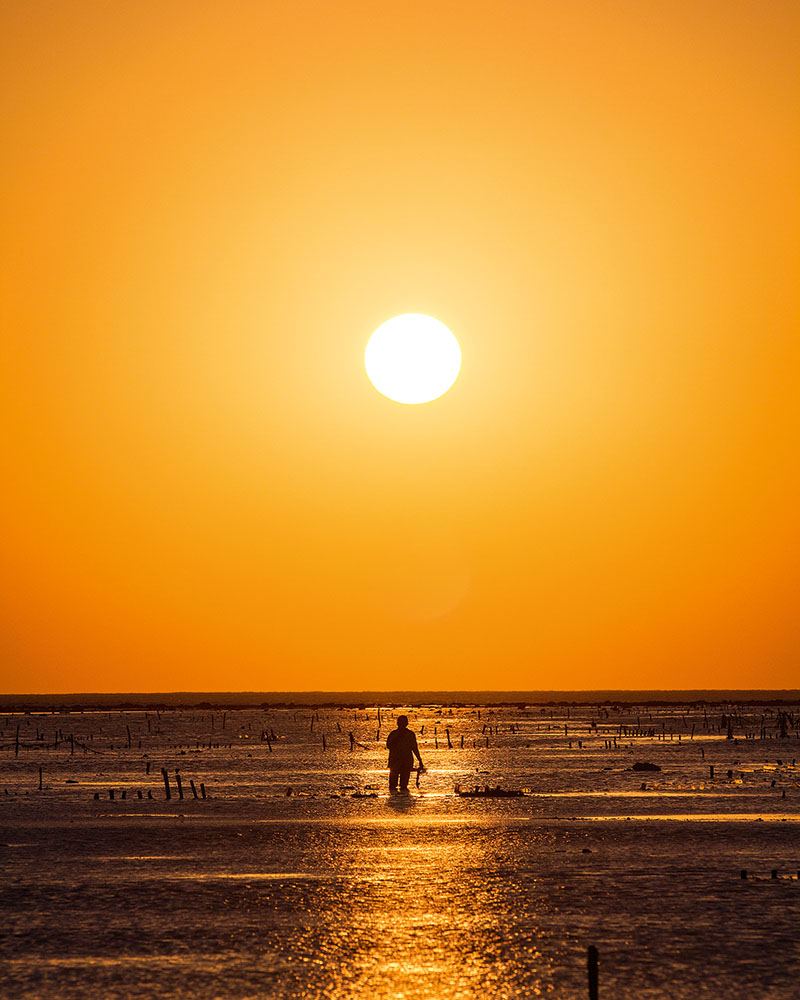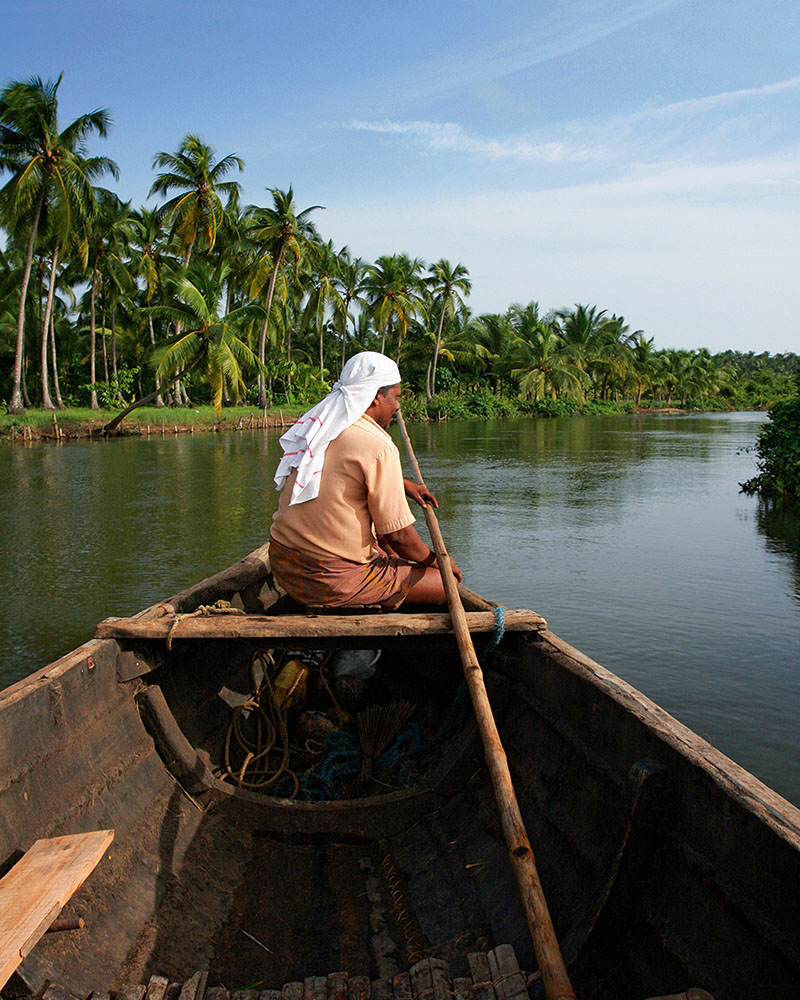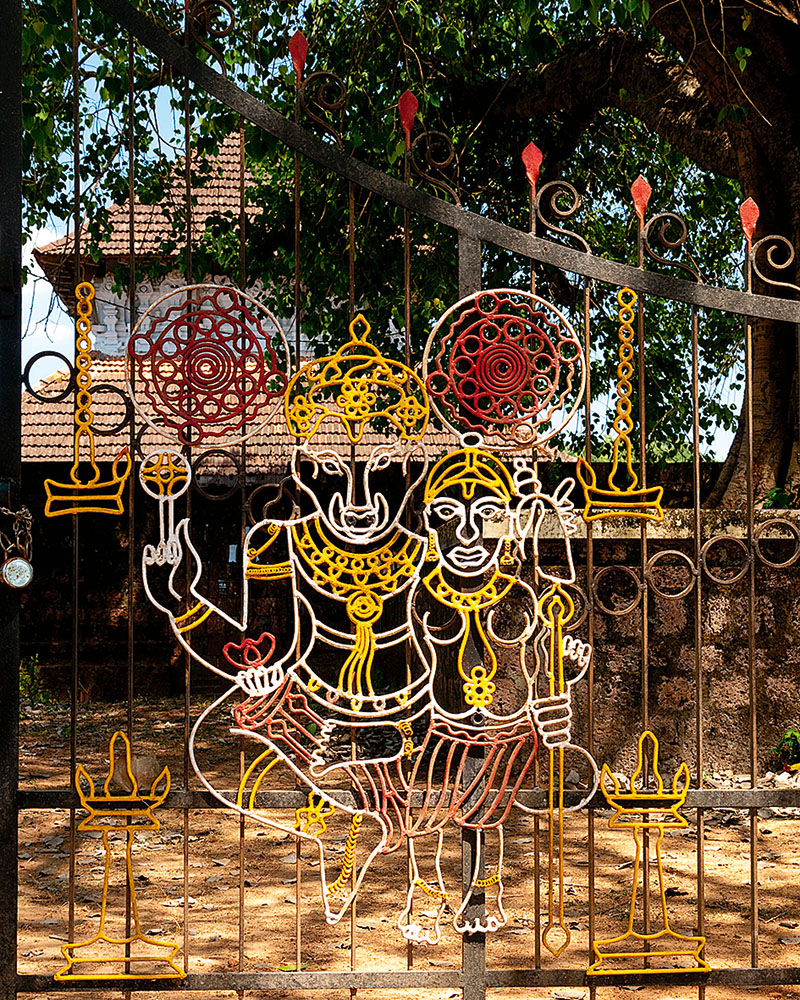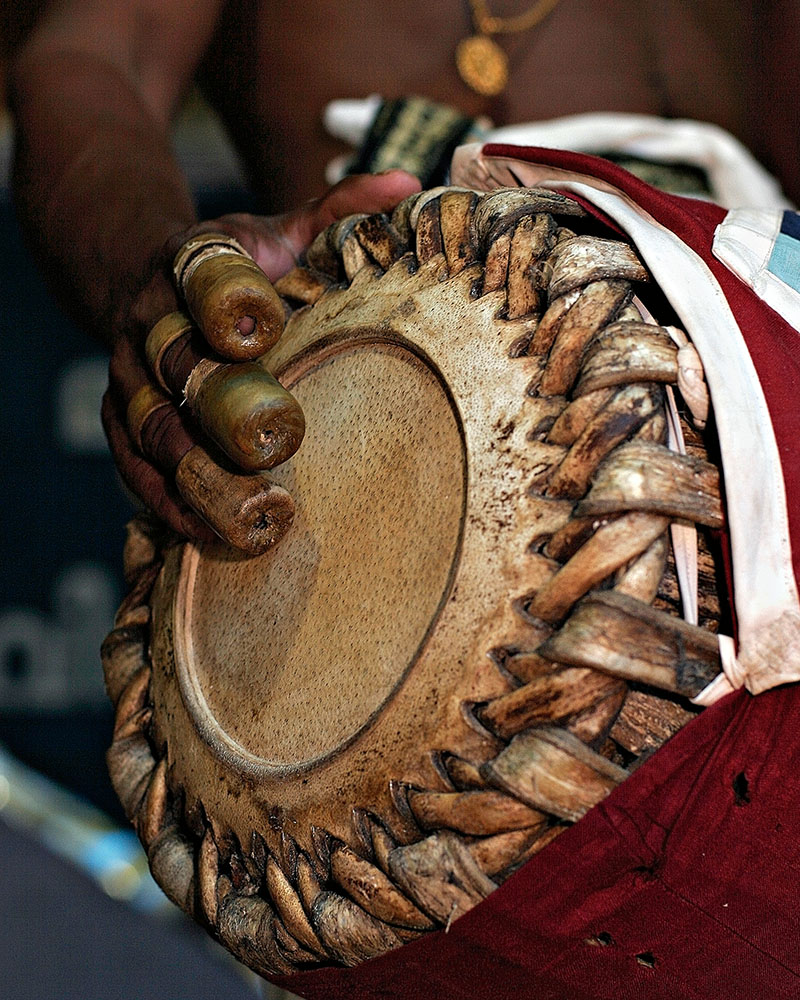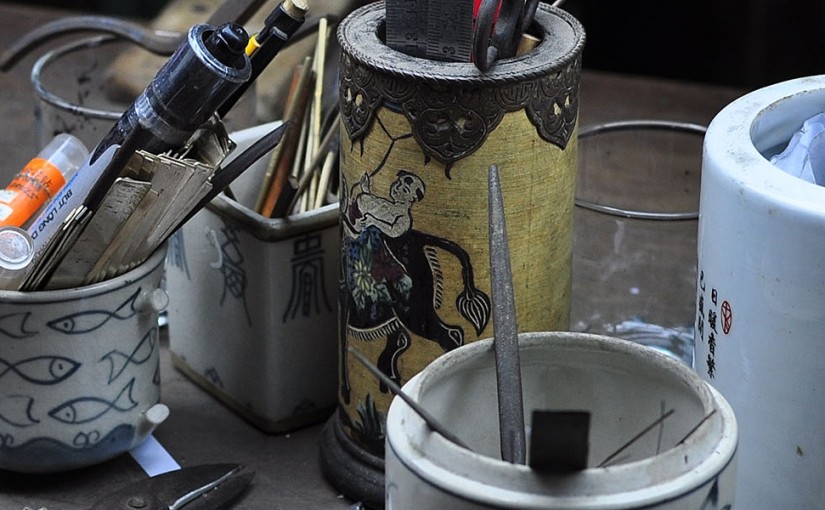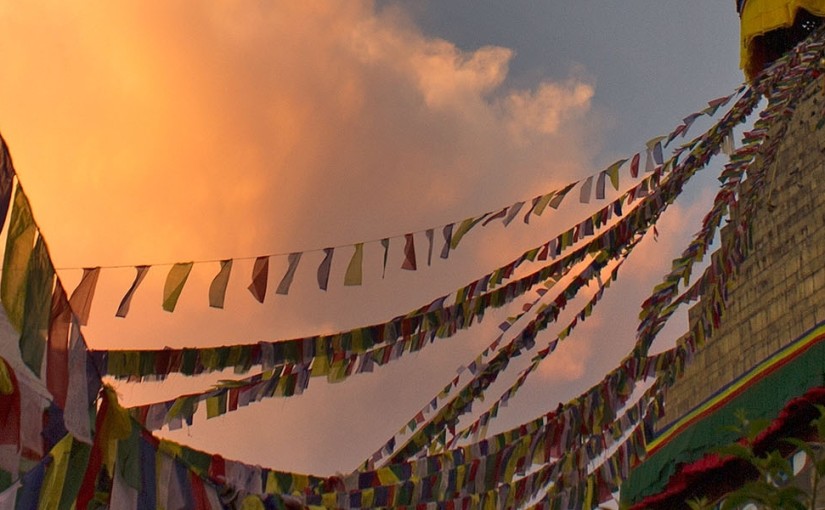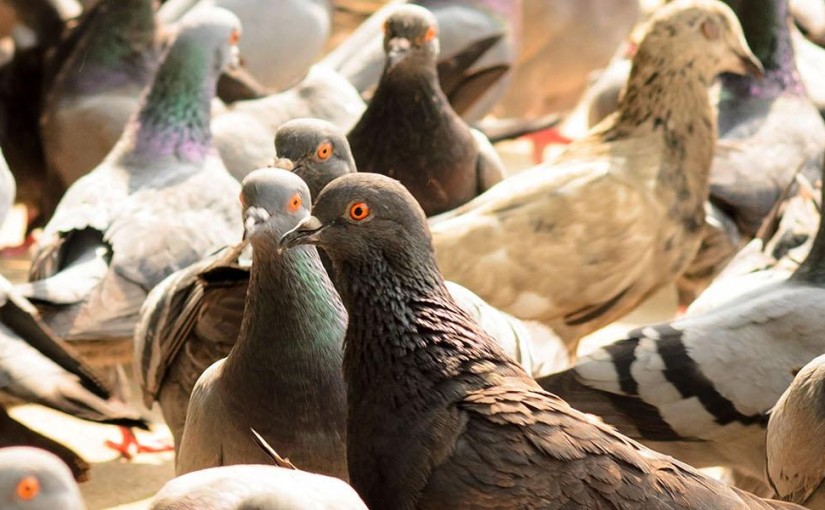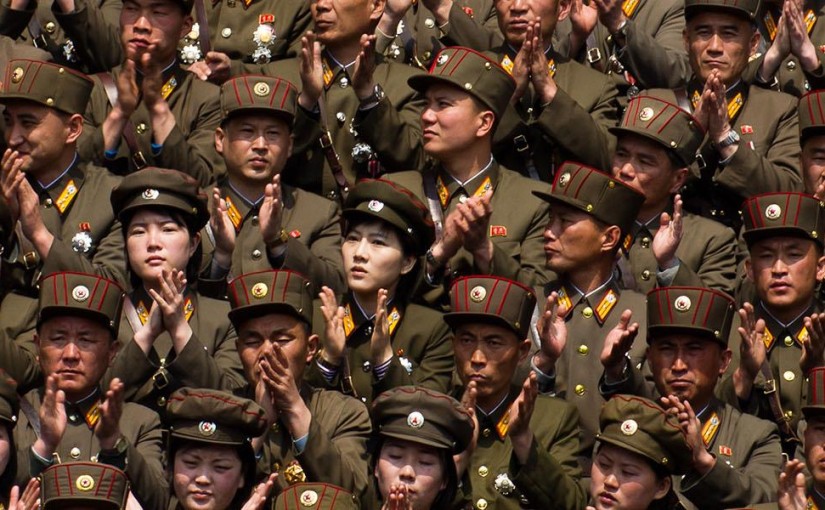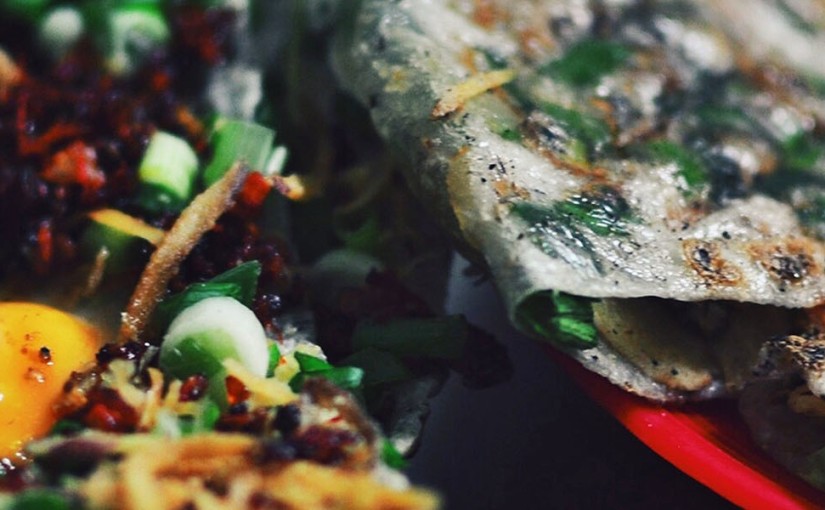However, away from the crowds who typically browse Nakamise-dori, the pedestrian street leading up to the temple that’s lined with stalls selling traditional sweets and kitschy souvenirs, is a truly charming neighbourhood made up of small lanes dotted with artisanal and multi-generational family-run shops. There is no need for a supermarket selling mass-produced goods, as everything can be bought at stores specialising in just one type of product.


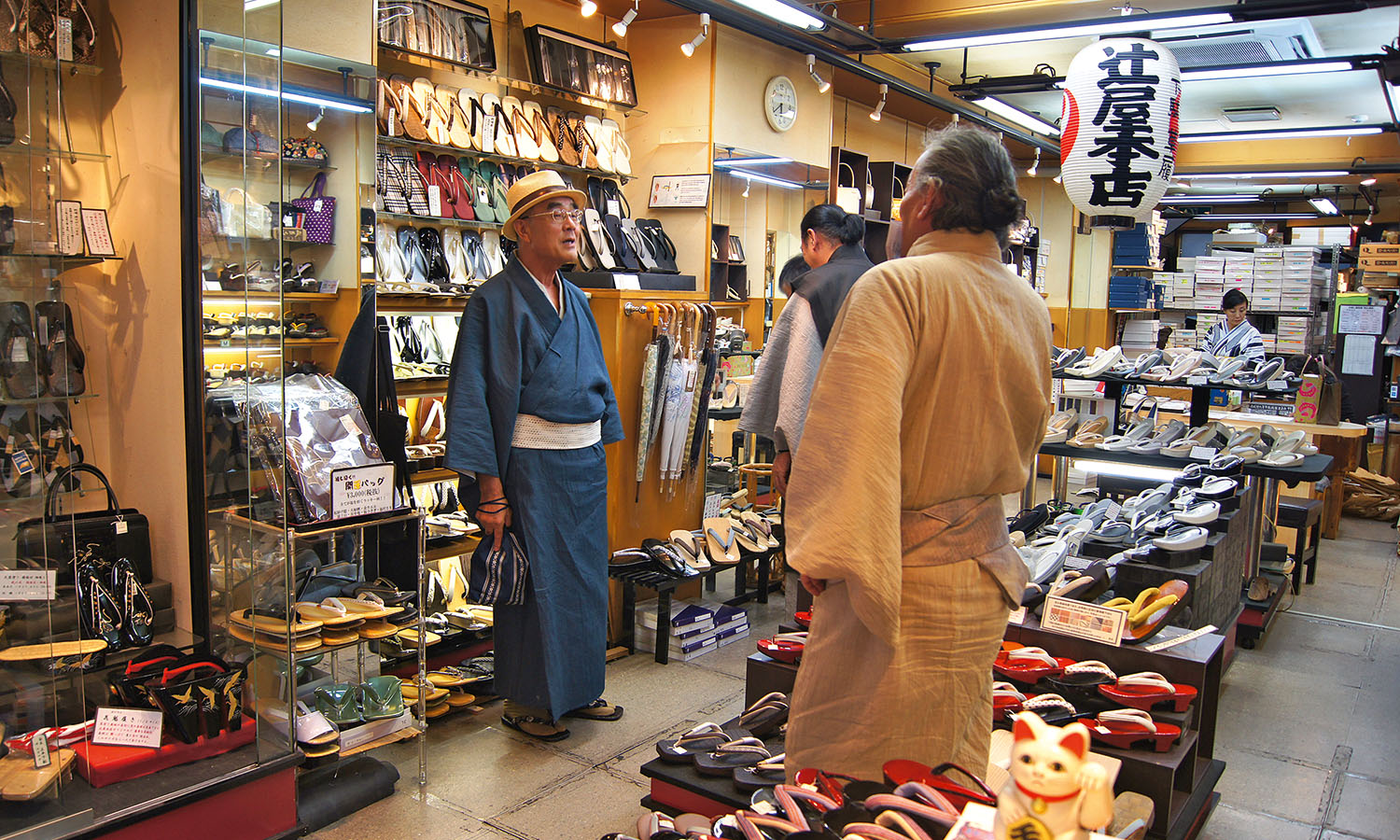

In the Edo period (1603 to 1868) the neighbourhood was popular with commoners and merchants. At the time Japan was enjoying a period of political stability and, thanks largely to this peaceful climate, cultural endeavours flourished. In opposition to the elegant and refined tastes of upper-class Tokyo, the downtown area developed a bawdy reputation. Ironically, various aspects of Japanese culture that are lauded now – woodblock prints, kabuki theatre, even tattoos – were, during the time, produced by the commoners for the commoners.
The locals who live here now have a fierce parochial pride and a brash sense of humour. The spirit of the community is evident during the many matsuri (festivals) that take place during the year. The most incredible of these are the Sanja Festival, which takes place on the third weekend each May and resembles one big street party, and the Sumida River Fireworks Festival in July.
Increasingly, the area has become a hotbed for members of the creative class, who find the rent in trendy west Tokyo areas prohibitively expensive. Their arrival has helped create a unique neighbourhood, where old-school craftsmen and new-wave designers exist side by side.
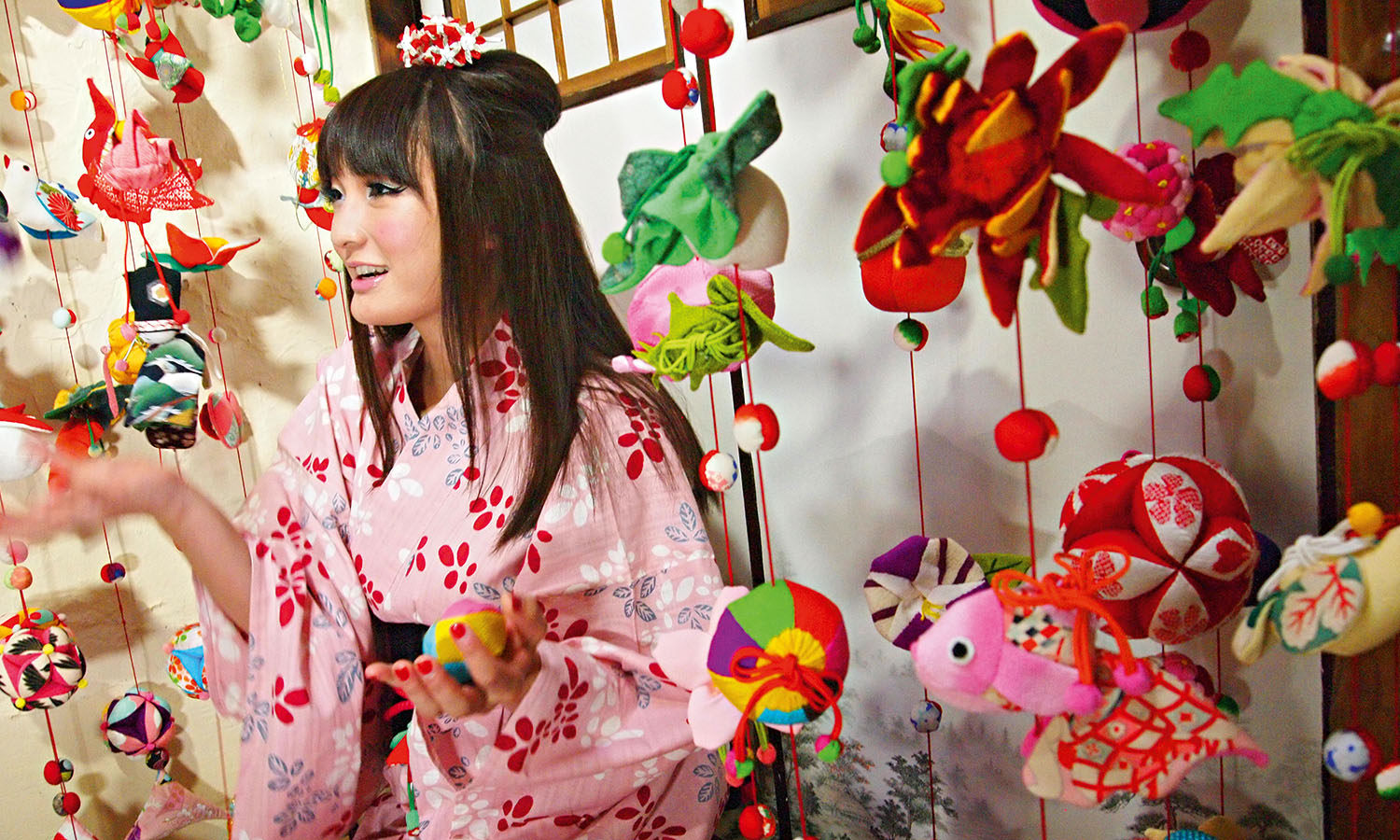

For visitors, there are a number of hotels in Asakusa, but Taito Ryokan – a small Japanese inn, built in 1950 – is a good choice. For Tokyo, it’s very cheap (about US$25 per person), with atmospheric tatami-style (straw mat) rooms and a friendly owner who makes the whole experience more like a homestay.
Asakusa has a plethora of artisan food stores – some sell only one kind of dried fish, for example, while others specialise in tofu. Kintaro-ame is a style of classic Japanese sweet and the most famous shop making it is the fifth-generation Kintaro-ame Honten. Long sugary ropes are assembled together, stretched then cut to reveal a pattern – most often a character’s face – within.
Stop for a break at Gallery éf. This Edo-era warehouse, built in 1868, is one of the few buildings that survived the fire-bombings of World War II. The space retains its architectural charm, but now serves as a cultural hub cafe, bar and gallery – with a cosmopolitan clientele. Exhibitions range from Yutaka Kamimura’s photography of cats and dogs living in the Fukushima nuclear evacuation zone to NYC shooter Paule Saviano’s burlesque images.
While Senso-ji is the most famous temple in the area, you can find numerous shrines nestled inconspicuously between buildings. The small Yoshiwara Benzaiten Shrine is surrounded by cherry blossoms that bloom gloriously during spring. Although legal reforms saw courtesans disappear from Tokyo life during the mid-50s, they used to come here, once part of the city’s biggest red-light district, to pray for protection.
One of the most atmospheric sentos (public baths) in Tokyo is Onsen Jakotsu-yu, nestled in Asakusa’s laneways. Sentos were common in the region post-war, as many houses did not have their own bathrooms, but locals still attend them – yes, in their birthday suits – for the community atmosphere and sense of ritual. The water that flows in Jakotsu-yu comes from deep in the ground and is rich in minerals, leaving skin smooth and soft. This is also one of the few bathhouses in Japan where people with tattoos can bathe.
One recent transplant to the district is yukata (kimono) maker Rumi Shibasaki, who works out of her atelier, Rumix Design Studio. She makes cotton kimonos infused with a rock ’n’ roll sensibility – the dramatic motifs include images referencing all aspects of pop culture from Alfred Hitchcock films to novels by Yukio Mishima. She does, however, use traditional dyeing methods that utilise meticulously detailed, hand-cut stencils. Each yukata is stitched to order, so you can go in, get measured up and have a kimono made especially for you.
What to wear with your Rumix yukata? The answer is footwear from Tsujiya Honten, a traditional footwear store that makes geta, zori and setta, which are similar in shape to flip-flops but have the sturdiness of clogs or sandals. Each pair is custom-made by an in-house creator who fits them to your foot. They are beautiful, comfortable and, as an added bonus, go really well with jeans. A visit to the store is always great for people watching, as customers, from elegant gentlemen in their finest kimonos to first-time fashionistas, wait to have their sandals tailored to them.
The first time I went to Miyoshi, a small restaurant in the heart of Asakusa, it was by invitation of a local tattoo artist who goes there every second day to eat. It has unassuming interiors and a low-key atmosphere, but excellent fugu. While the taste of this famous pufferfish (poisonous if prepared incorrectly) is subtle, the presentation – delicate slices fanned out on a plate – and the texture of the sashimi is what makes fugu such a speciality in Japanese cuisine.
One of the best nightspots in Asakusa is Oiwake. The food served is typical of an izakaya – drink-friendly yakitori (meat grilled on skewers), edamame (soybeans still in their pods), house-made tofu and the like – and is downed with plenty of beer and sake. The real attraction here is the entertainment. At this bar young musicians play folk songs from north Japan with shamisens, a lute-like instrument that is strummed vigorously to produce a melancholic sound. The playing is so fervent and energetic it has been likened to that of Jimi Hendrix. Afterwards, when they’ve finished their set, the musos mingle with the crowd. That’s just the kind of place Asakusa is.
No Further South
I am in Kupang, West Timor’s grim capital and the first stop on a journey in search of the fabled “Bali of 20 years ago”. Depending on whom you ask, it still exists in far-flung isles around the Indonesian archipelago, and I’d heard whispers of a small island called Rote. Depending on the whims of the local weather, it’s a three-hour ferry ride from Kupang.
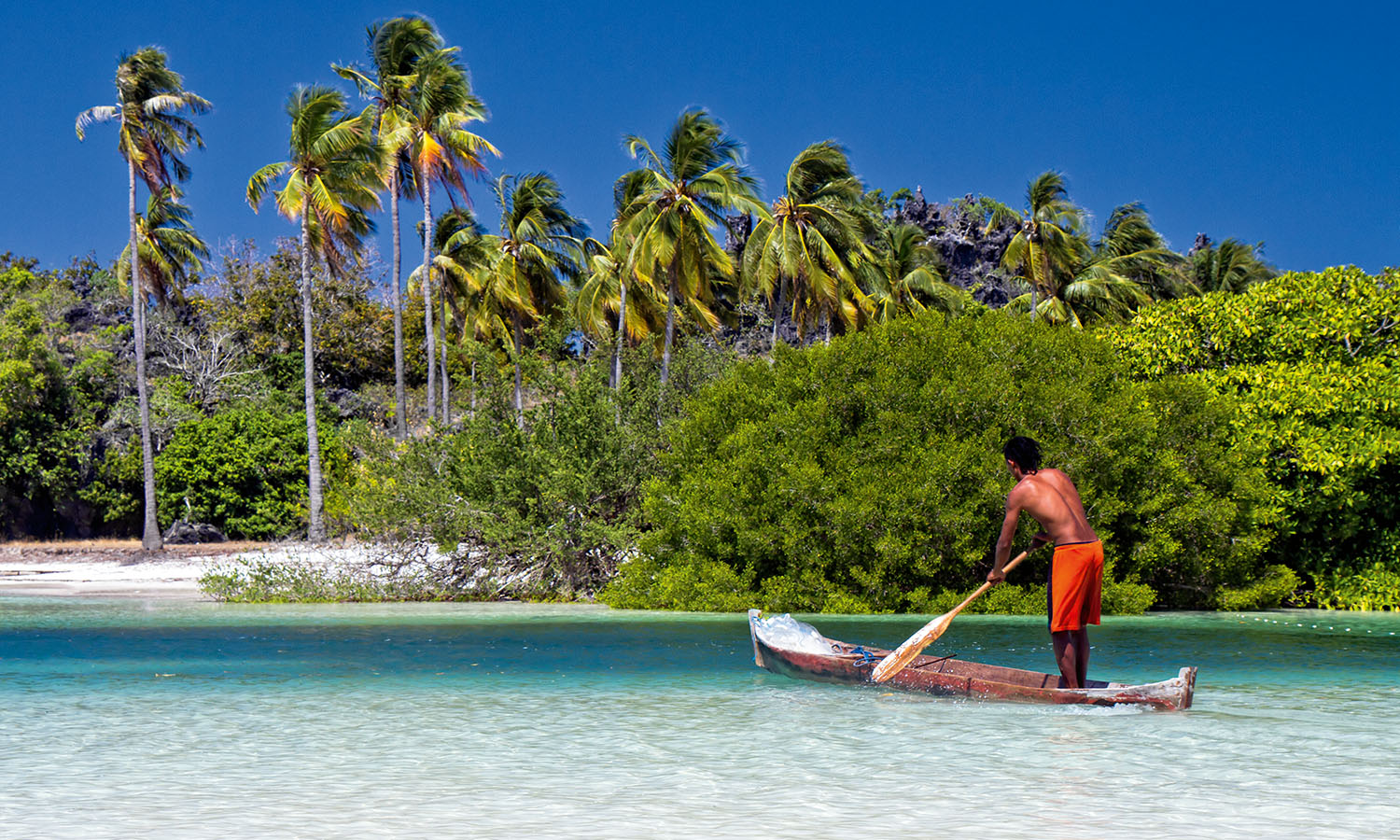

An overnight stop in Kupang is required for anyone travelling to Rote. All going well, the morning after your arrival, a ferry will take you across the Pukuafu channel. The dramatic confluence of the Indian Ocean and Timor Sea, Pukuafu is a stretch of water where strange currents, whirlpools and walls of chop bounce off jagged islands lined with volcanic stone, ensuring a harrowing journey. It is renowned as one of the deadliest stretches of water in Asia, even by Indonesia’s dodgy public transport standards. In recent years the crossing has seen more than its share of sinking vessels and lives lost. My arrival in Kupang has coincided with a not-uncommon run of strong winds with the potential to cause even more perilous conditions for the former European River Cat that is ill-designed for its use here. Mornings quickly turn into a routine of loading luggage onto the ferry, fighting for space, then sitting as the wind swells before heading back to town to do it all again the following day.
Kupang is a busy port with few redeeming features other than an impressive night market, serving the freshest catch of the day and regional specialities for next to nothing. The town was occupied by Japanese troops during World War II, which in turn saw it battered by numerous Allied bombing campaigns. Walking along the waterfront today, it’s not hard to imagine the place in the days after the raids. The buildings are a mix of the decrepit and crumbling, with no hint of charm and a thick layer of dust.
Captain William Bligh found his way here after the mutiny on the Bounty, and small reminders of his sojourn can be found around town, most notably in the one decent drinking hole on the waterfront, which has great old maps and memorabilia on display. The open-sided bar is a gathering place for a smattering of travellers and expatriates, many of whom are pickled from the early hours of the day. At best, they make for awkward company. The clang of the saloon-style bar doors is often the only break from their war stories of love and fortunes won and lost. After a little time in Indonesia one can recognise these characters pretty quickly, their downtrodden tales echoing through dusty bars from Timor to Sumatra. After my own recent break-up, I vow never to join them, although it dawns on me I am in much the same position. At least I’m keen to keep moving.
Thankfully, a change in the weather brings my bout of fear and loathing in Kupang to an end. Finally the ferry sets sail and I find myself in the small town of Nemberala on the spectacular palm-lined north-east coast of Rote. Rote sits just off the edge of the Australian continental shelf, a mere 170 kilometres west of Australian territory at Ashmore Reef. It’s so close to the lucky country the dry-season trade winds sweep up dust from the Red Centre – combined with the tropical sunshine, it conjures some of the more spectacular sunsets you can imagine.
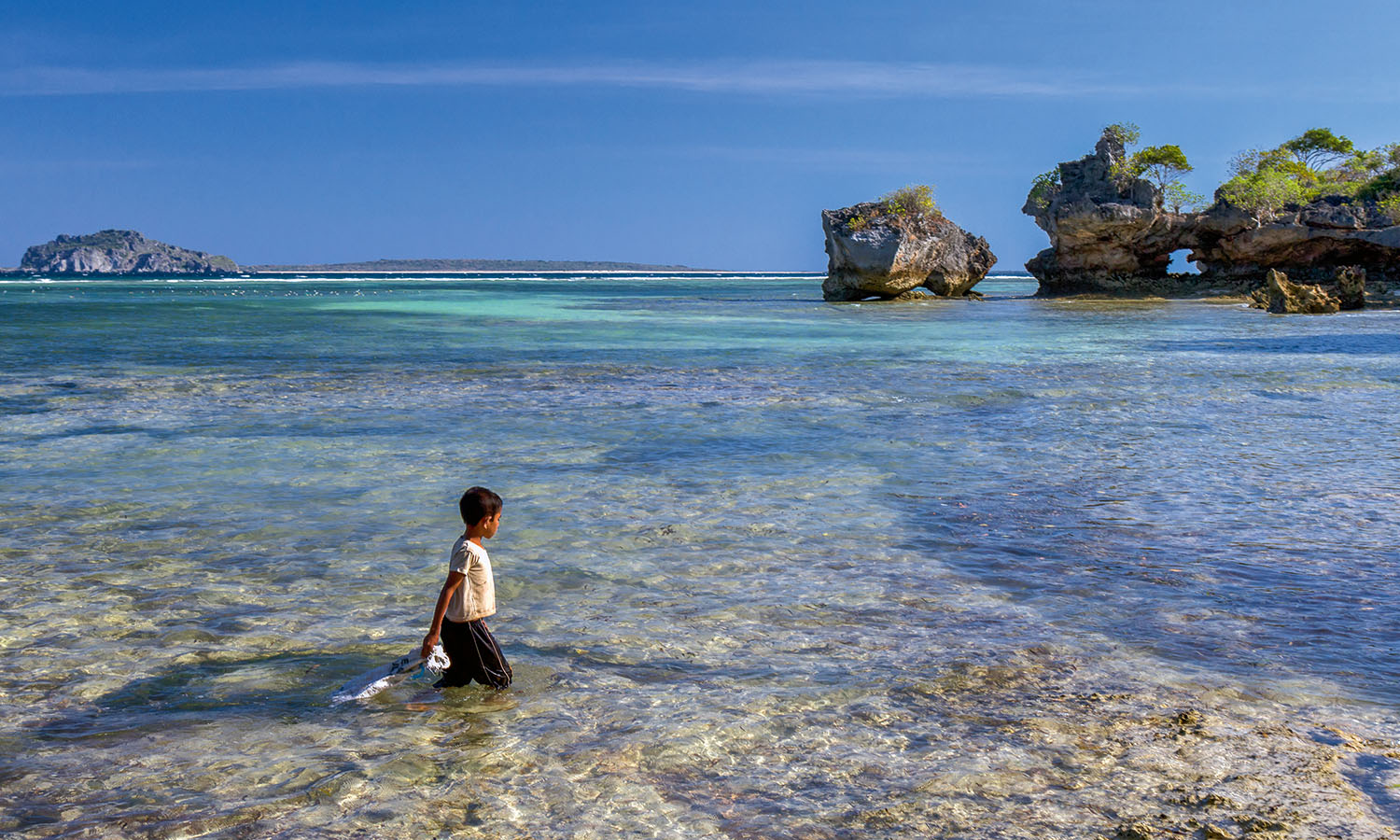

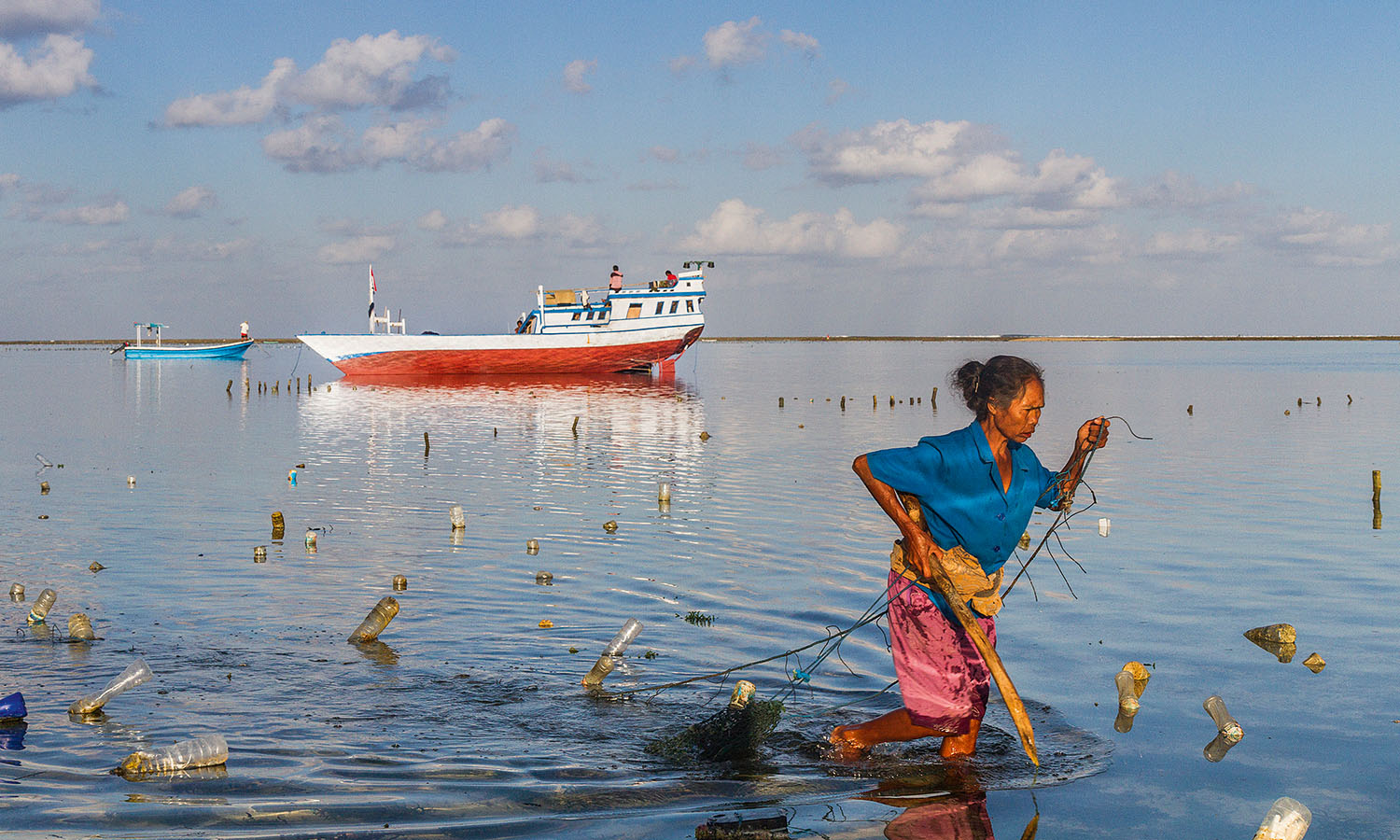

Facilities are still basic in Nemberala. Water is drawn from wells prone to typhoid contamination. Generators produce power only in the evenings and on Sundays, and there’s patchy to no internet. Malaria is also a real threat, with little in the way of treatment should you succumb. The distinct possibility of being stuck on the island for extended periods only adds to the risk of travel here.
Surfers make up the majority of tourists on Rote. In the late 1960s a Peruvian world surfing champion, Felipe Pomar, set up a small homestay and has lived here since. The main wave is called T-Land, in recognition of a similar wave in Java, although some refer to it as Old Man’s Left, since the expats who surf it are generally of advanced years. It’s a long, left-breaking wave in relatively deep water compared with many headline Indonesian breaks. Other travellers, however, are slowly catching on to what Rote has to offer: friendly locals, truly stunning beaches and the simplicity of a life far off the grid.
Around the time Pomar crossed Pukuafu, surfboard in hand, James J Fox, a US-born, Australia-raised anthropologist, also made the journey over the channel. His motivation was not the search for perfect waves but to document the rich culture of the Rotinese people. Fox brought with him a small tape recorder, which the locals quickly dubbed “the voice catcher”. Catcher in hand, Fox set about recording the oral histories of the Rotinese. The picture painted through his work is of a proud Christian tradition woven with local legend as well as a fierce independence from outside rule. The Western religious influences are quickly evident as you traverse the island’s patchy and often dangerous roads. Whitewashed churches dot the island, surrounded by swaying lontar palms, picket fences and mobs of cheeky kids yelling “bulle” (Indonesian for foreigner).
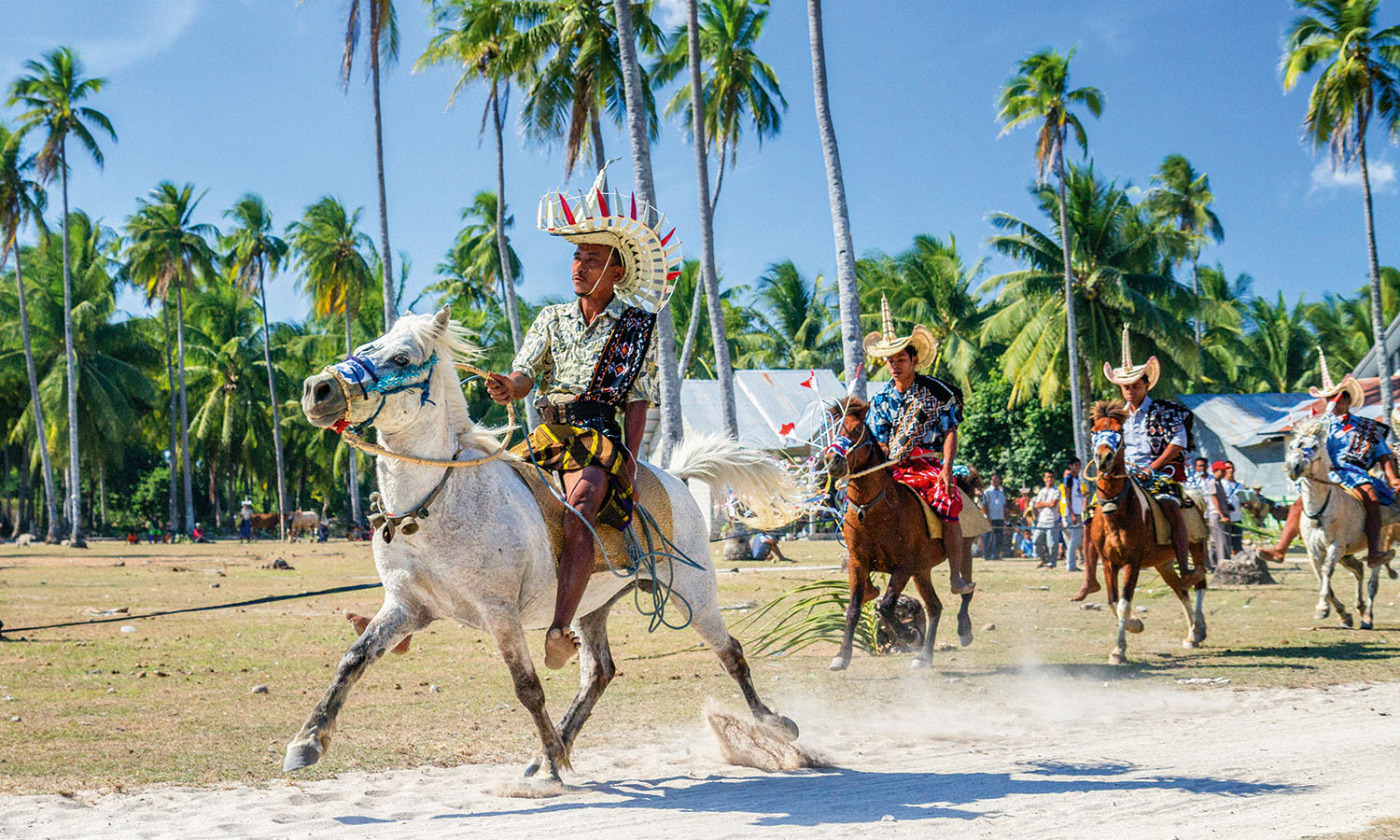

Alongside stray animals and hordes of kids, Rote dishes up surprises around every corner. Dirt tracks often lead to small fishing villages, home to groups of Muslim fishermen famous across the archipelago for their seafaring skills. On Rote these groups still eke out a simple living subsisting on the daily catch, while practising Indonesia’s majority religion as the minority on this distant outpost. A highlight of my time on Rote is a few afternoons spent with one of these groups, watching them fish in their small bay and photographing faces that say more than I could ever pick up with my average Bahasa.
A few times a year you might be lucky enough to catch the local horse races. The method of determining the winner of these events seems a mystery to almost everybody. As far as I can tell, important factors include a combination of the best-dressed horse, its speed around the track and the rider’s dexterity in smoking a lung-busting Gudang Garam clove cigarette with one hand while controlling the reins in the other.
Another entertaining feature of life in Nemberala is the village pigs. They rule the streets here, ambling around town, hanging out under trees, sniffing the vast reef at low tide for a feed of crabs, and playing chicken with speeding mopeds. These pigs are as free-range as it gets, enjoying the benefits of their sty-free existence while awaiting their day of reckoning, which may come in the form of a wedding or Christmas feast.
The Rotinese have the distinction of being the first group to expel the Dutch, years before formal independence for Indonesia was achieved. As it was for the Dutch, some visitors find their time on Rote is not all carefree days swinging in a hammock waiting for the right tide and winds before going surfing under blood-red skies. Being the closest port to Australia, this is a stopping point for boats carrying refugees further south. Overloaded decks are stuffed with people seeking the sort of comfort and security most travellers on Rote are escaping, at least temporarily. Local stories abound of boats landing here or on small neighbouring islands, their passengers informed they’ve arrived in Australia then left to their own devices.
I also hear of boats sinking just offshore. Quite possibly at least some of these may go undocumented – another part of the often faceless toll of humans lost while seeking a better life in Australia. Reflecting on my earlier stresses – barely a minor inconvenience in comparison – I can only thank my lucky stars I get to travel to a place like this, enjoy the best of what it has to offer before returning to my privileged existence at home.
Rote is a spectacular place, and while I never got to visit that famed Bali of 20 years ago I’d hazard a guess this is every bit the joyful escape those early travellers found on the paradise island. Just hope for the winds to be in your favour, and save a thought for those heading further south.
Go with the flow
Not quite. But he has valiantly steered a vessel made from nine sticks of bamboo and three inner tubes through the rain-swollen rapids of the Thuthapuzha River. And he’s done it while manhandling the weight of a mutinous crew, who’ve spent the first half of the trip figuring out which way round to hold our oh-so-rustic bamboo oars, and the rest of it filling them up with water to tip over each others’ heads.
Welcome to the not-so-extreme sport of monsoon rafting, Kerala style. The Thuthapuzha may be the wildest tributary of one of South India’s most storied rivers – the much-mythologised Nila – but in a proper rubber raft its rapids would struggle to rate Grade One. Yet when your feet are braced against bamboo struts lest they get crunched by submerged rocks, and when even the gentlest riffle can slosh up through the inner tubes to give your nether regions a complete soaking, this most primeval form of river travel gives you a joyous sense of not just floating along on top of a river, but actually flowing along in it.
The credit for rejuvenating the formula of wood plus rope plus something buoyant equals a sodden good time belongs to Gopi Parayil, a native of the banks of the Nila. Gopi experienced an epiphany when he returned from London to tend his ailing father, and found his beloved river to be faring no better herself.
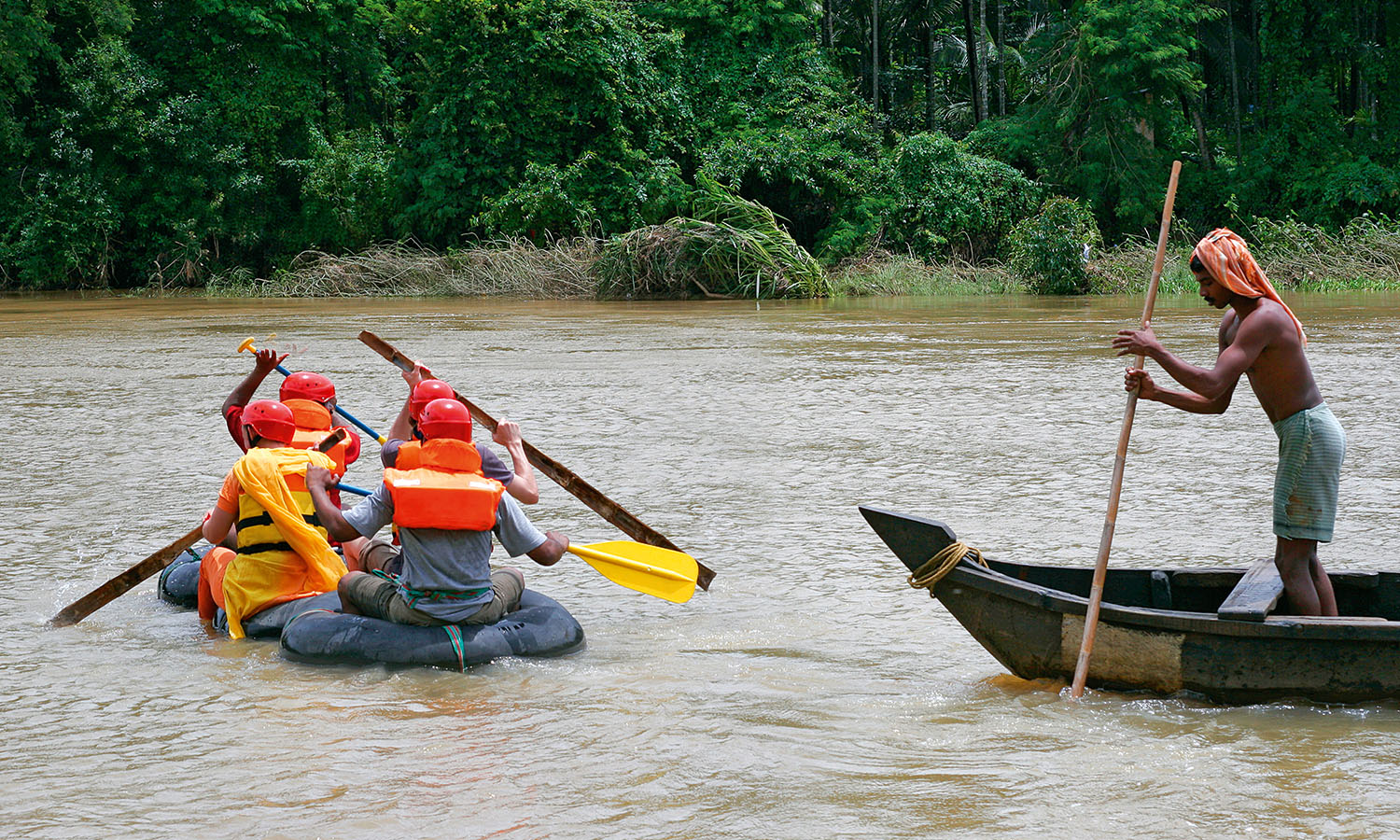

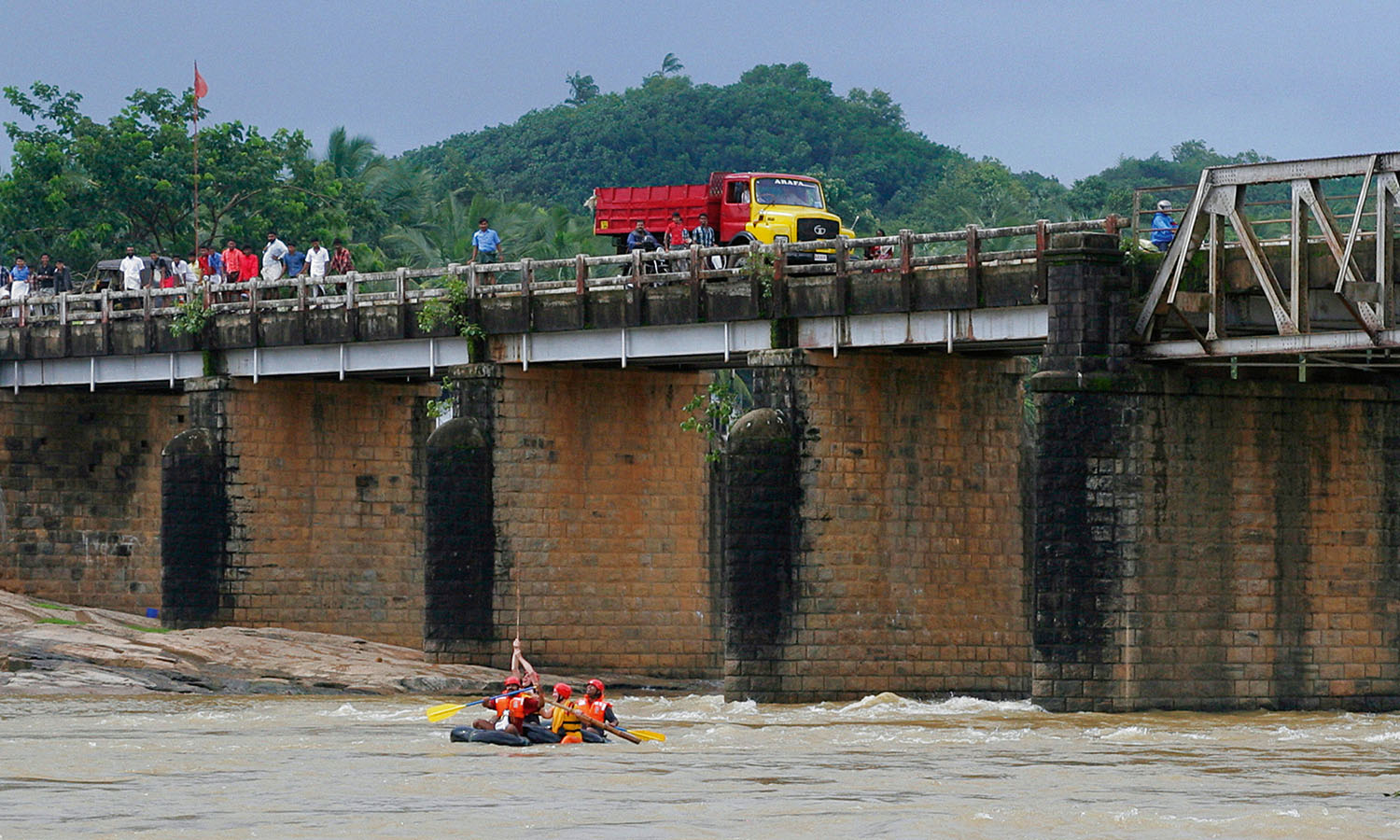

“We believe that bathing in the Nila frees the soul of its liabilities,” he explains, as we gaze out across a sluggish, sandbank-lined reach of the river. It’s the third week of July, supposedly the peak of India’s southwest monsoon, and still the river barely manages to cover its sandy bed. “It broke my heart that there was hardly enough water in the river for my dad to take a dip.”
Its modest 290-kilometre length utterly belies the place the Nila holds in Kerala’s spiritual and cultural life. Many of the state’s signature performing arts have been fostered along its banks, from the outlandishly costumed solo dance spectacle of Thullal to the cacophonous classical music that soundtracks lavish temple festivals like Thrissur’s Pooram.
In the village of Cheruthuruthy, Gopi leads me through the leafy grounds of the Kerala Kalamandalam, a university for the performing arts, where the drummers, temple dancers and Kathakali artists of tomorrow study their art in open-sided classrooms. It all feels very industrious and idyllic. Yet just as the river has come under assault from sand miners, dams and deforestation, the Nila’s culture is fighting its own battle for survival. Youngsters, lured to the city by the chance of a lucrative IT or call-centre career, are no longer willing to accept the often impoverished life their parents may have endured in the name of art.
“Kids need modern education, but that doesn’t mean you need to say no to what you know,” Gopi tells me. “Once you lose what you’ve inherited, you can’t make it again on a day-to-day basis.” Hence his mission: to rebuild pride in traditional culture and prove to local families that the old ways, activated by the participation of interested travellers, can still carry an economic imperative. That’s why the next morning, rather than loading into a standard-issue imported rubber raft, I find myself sawing and chopping and lashing together lengths of bamboo – bought from local growers at rates that make them sit up and take notice – while Captain Lukose carves away at a pair of elegant, organic oars. Once the inner tubes are made fast to the frame, and with a bag of jackfruit chips lashed on for sustenance, the Bamboo Pearl is ready to set sail. Grabbing a corner each, we heave her into the shallows then paddle hard for the middle of the river, where the current sweeps us up.
To call the Thuthapuzha a raging torrent would be to somewhat stretch the point. For the most part it bubbles along merrily, occasionally breaking into a canter where the river runs over submerged rocks, at other times slowing to an ooze and offering the chance to flop over the side for a swim. At one point the sky goes black and a moist monsoonal wind whips up white horses, forcing us to paddle madly into the teeth of a majestically intense downpour that stings our cheeks and makes the water around us fizz like acid.
It soon becomes evident the Bamboo Pearl has the potential to be a perfect raiding vessel. Several times we drift out from behind a boulder or a clump of trees to startle a half-undressed woman standing in the shallows beating the stuffing out of her sari. One elder casts an unimpressed eye over our vessel; she’s seen our like before, when real-life pirates swooped in on a similar bamboo raft and stole all her ducks.
The Pearl enters a tunnel of dark forest, and a group of children run to the riverbank and begin singing to us. Lukose sings back, leading them down the river like a waterborne Pied Piper. The rest of us are so absorbed in the lilting melody and the beauty of the scene that we momentarily let our oars drag in the water. Our leader turns around to sternly admonish us: “I sing. You paddle!” A stocky, bronzed water buffalo that’s mooched down to the shore for a quiet drink shoots us an offended look.
Just when the trip is in danger of becoming too languid for its own good, the stone bridge at Thootha lumbers into view, accompanied by the ominous roar of what sounds like a mini Niagara. Lukose, shoulders tensing, motions that we need to shoot for the middle arch. But we’re hopelessly off course to the right, the current quickening with every second, and a crowd of onlookers begins to gather on the bridge, eagerly waiting to see us get smashed to pieces against the piers.
Suddenly the crew of the Bamboo Pearl meshes together. Spearing our oars into the rollercoaster waves we pull desperately towards the centre channel, groaning and swearing like a team of navvies digging a ditch, as the stone pillars loom menacingly close. With seconds to spare the boat catches the current funnelling under the main span, and our howls of triumph echo off the walls of the Gates of Deliverance, dampened not at all by the tidal waves of muddy brown water erupting from under the floor. The crowd on the bridge stays mute; it’s not every day you get to see a raftload of foreigners chomped to bits, and we’ve cruelly denied them.
Sore and blistered but triumphant, we row the brave Bamboo Pearl to the left bank and haul her out of the water, to be greeted by a volley of questions from the lungi-bedecked welcoming committee. Where have we come from? What are we doing here? Have we, perchance, any ducks for sale?
As for the boat, like a bamboo Titanic, her maiden voyage is also to be her last. As Gopi and Lukose squash the air out of the inner tubes, a couple of local guys shoulder the bamboo frame off down the street – perhaps to be turned into scaffolding or firewood, or maybe, just maybe, to be treasured as an heirloom and displayed to the wondering eyes of grandchildren for generations to come.
That evening we’re invited to a feast of spicy dal and flaky flatbreads in the grounds of an old Keralite mansion outside Arangottukara. The house belongs to a member of the Vayali folklore group, who got together in 2003 to revive the songs and dances native to their rice-growing villages.
As the purple clouds of a monsoon dusk slowly fade to black, Vayali’s singers – porters and labourers during the day, gods and goddesses of the paddy field by night – unleash a sequence of rustic and hypnotic campfire songs, each one delivered by a choir of soaring voices to the accompaniment of the staccato boom-tap of the chenda (drum). Then, as raindrops spit into the dust, the ferocious demon Dharika, dressed for battle with a serrated brass moustache, squares off against the goddess Kali, herself resplendent in a crown of palm fibre arrows, frilly shoulder pom-poms and a metre-long beak fashioned from coconut palm.
Bare-chested drummers strike up a rhythm as the combatants begin to circle; Dharika’s blackened eyes wear an expression that verges on psychotic, as though his eyeballs have flipped inside out to gaze inward at some unseen horizon. As the drumming rises to a crescendo, the dancers lunge at each other, the homemade swords in their hands flashing wildly, forcing those of us in the ring of spectators to lurch backwards to save our skins. It’s a raw and wild spectacle, and a far cry from the predigested tourist-friendly product that passes for cultural performance in more travelled parts of Kerala.
Back at my hotel I sit out on the veranda into the early hours, watching vibrations of yellow lightning in the distance and listening as rainclouds sweep across the coconut palms like stealth bombers: approaching with the whoosh of an express train, unleashing pandemonium for a minute or two, then ceasing just as abruptly to leave a loud chorus of frogs in their wake.
It rains all night and through the next day. The Nila bursts out of her sandy chains and, for the first time in years, fills her channel to the brim. Gopi walks around grinning under a broad umbrella and calls all his friends. His river has returned, at least for now, and I can’t help sharing his joy. Having given myself up to the Nila’s flow and song, it’s become my river, too.
Visit Reaching Out Arts & Crafts
Reaching Out Arts & Crafts is a high-quality, fair-trade artisan market located in Hoi An’s Ancient Town. Many of the beautiful pieces at this ethical showroom are made by people with disabilities, allowing differently-abled people to receive fair wages and lead independent lives.
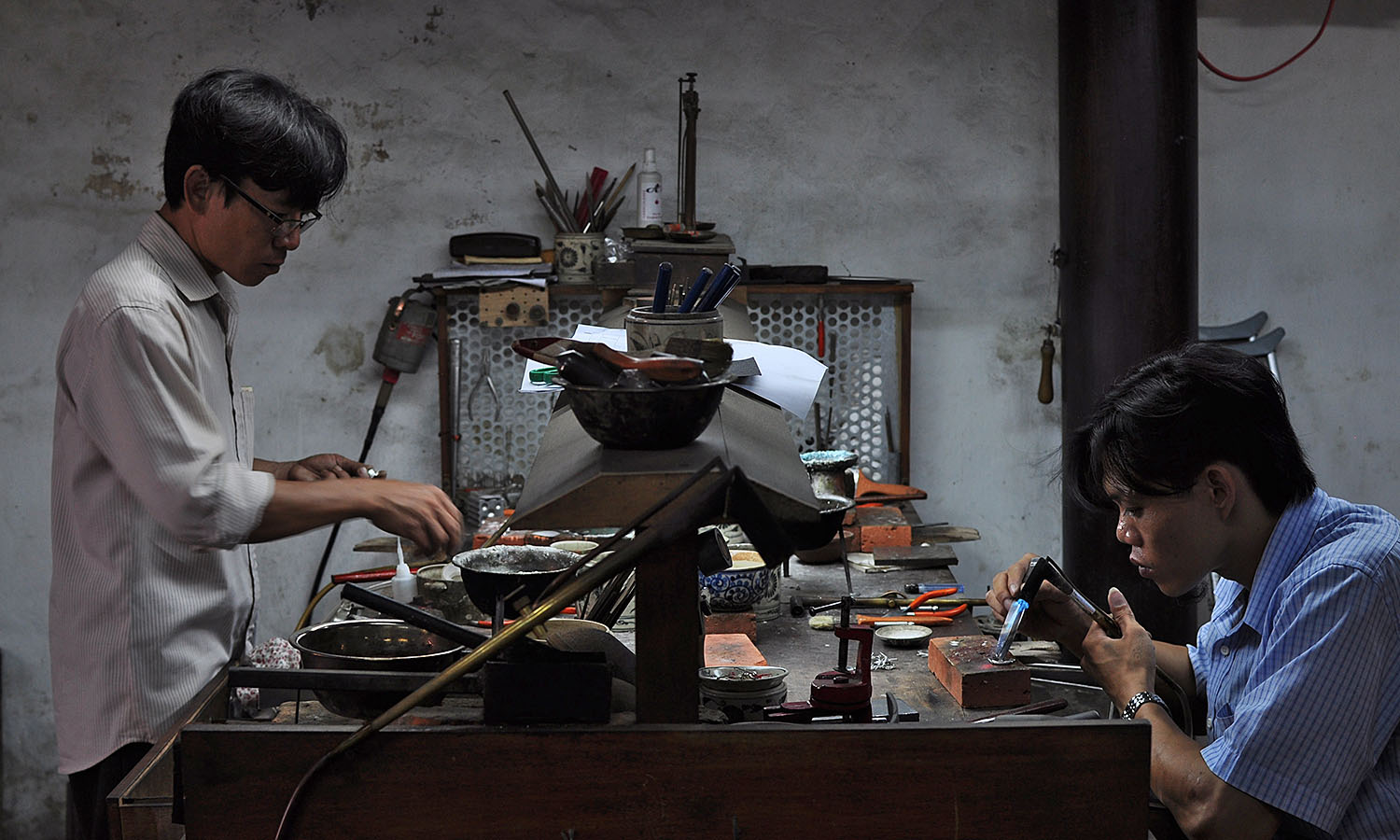

An abundance of bedding, bags, jewellery, stationery and toys can be found here – perfect presents for your return home. The real magic, though, can be found in the back of the shop, where you can have a peek at the artists working away at their fine handicrafts.
A Holy Pilgrimage: Boudhanath Stupa
In a city filled with the incessant tooting of taxis and rickshaws, and stall owners selling their wares, Boudhanath Stupa is a peaceful retreat nestled among the constant hustle and bustle of Kathmandu. Built during the fourteenth century, the stupa is situated near the outskirts of the city in Bouda, and has been an important place for pilgrimage and meditation for Tibetan Buddhists and local Nepali people for centuries.
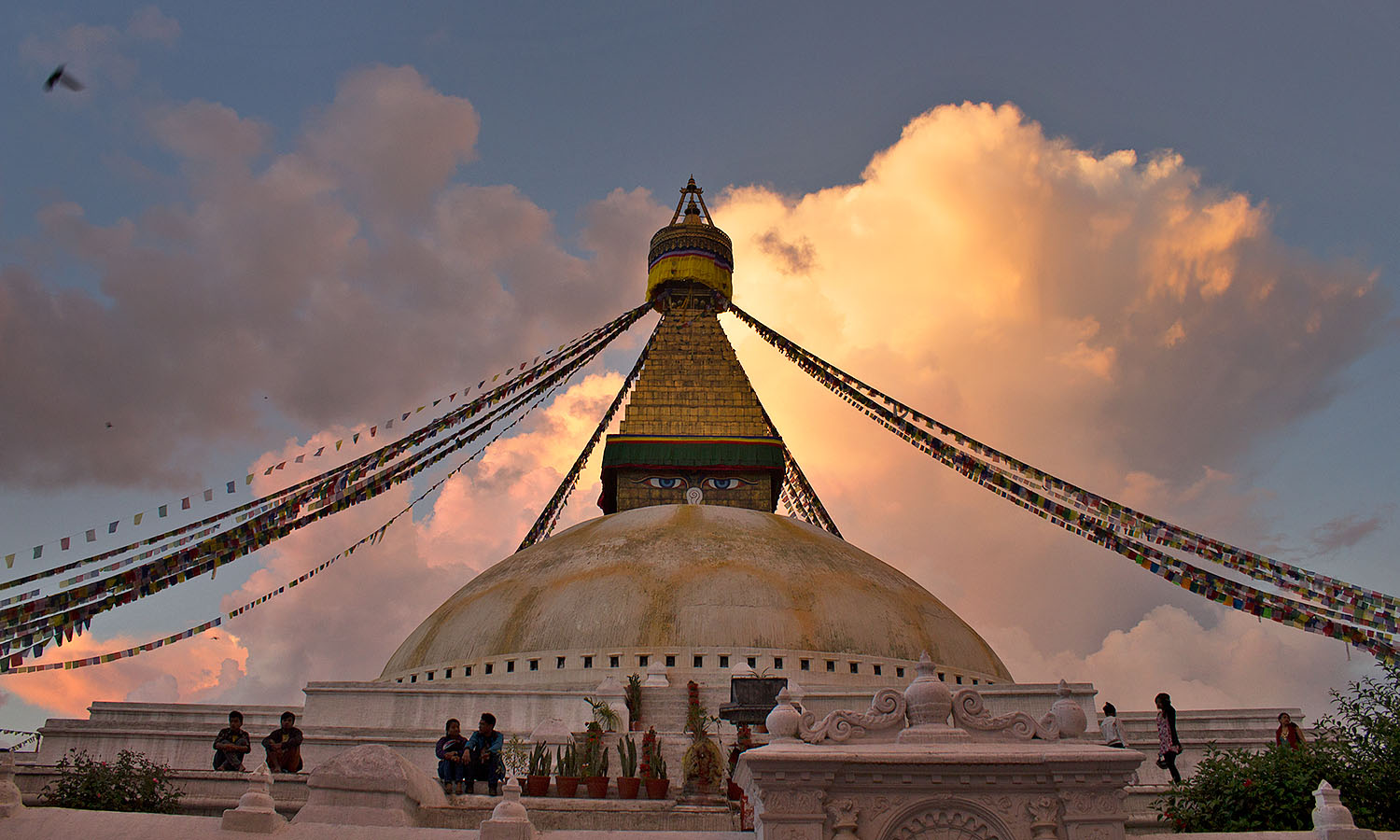

Get close to the divine as you walk around the white dome in a clockwise direction to pay your respects, inhaling sweet incense and blooming marigolds, listening to the hypnotic tune of chiming prayer wheels being turned and monks chanting as they make their way around the temple’s base. Once you’ve completed your journey, climb to a balcony at one of the surrounding cafes or the monastery for panoramic views of the city and mountains. Damaged during Nepal’s devastating 2015 earthquakes, the stupa is currently being restored but is still open to visitors who wish to experience its spiritual and humbling atmosphere.
Sky High at Cloud Lounge & Dining
Where can you chill out after a day sweating it out on the steamy streets of Jakarta? A drink in the freezing Vodka Room at Cloud Lounge & Dining is a good place to start. Knock back a shot in a climate-controlled zero degrees, then head outside into the night’s balmy embrace to thaw out. If the vodka doesn’t get you tingling the views certainly will.
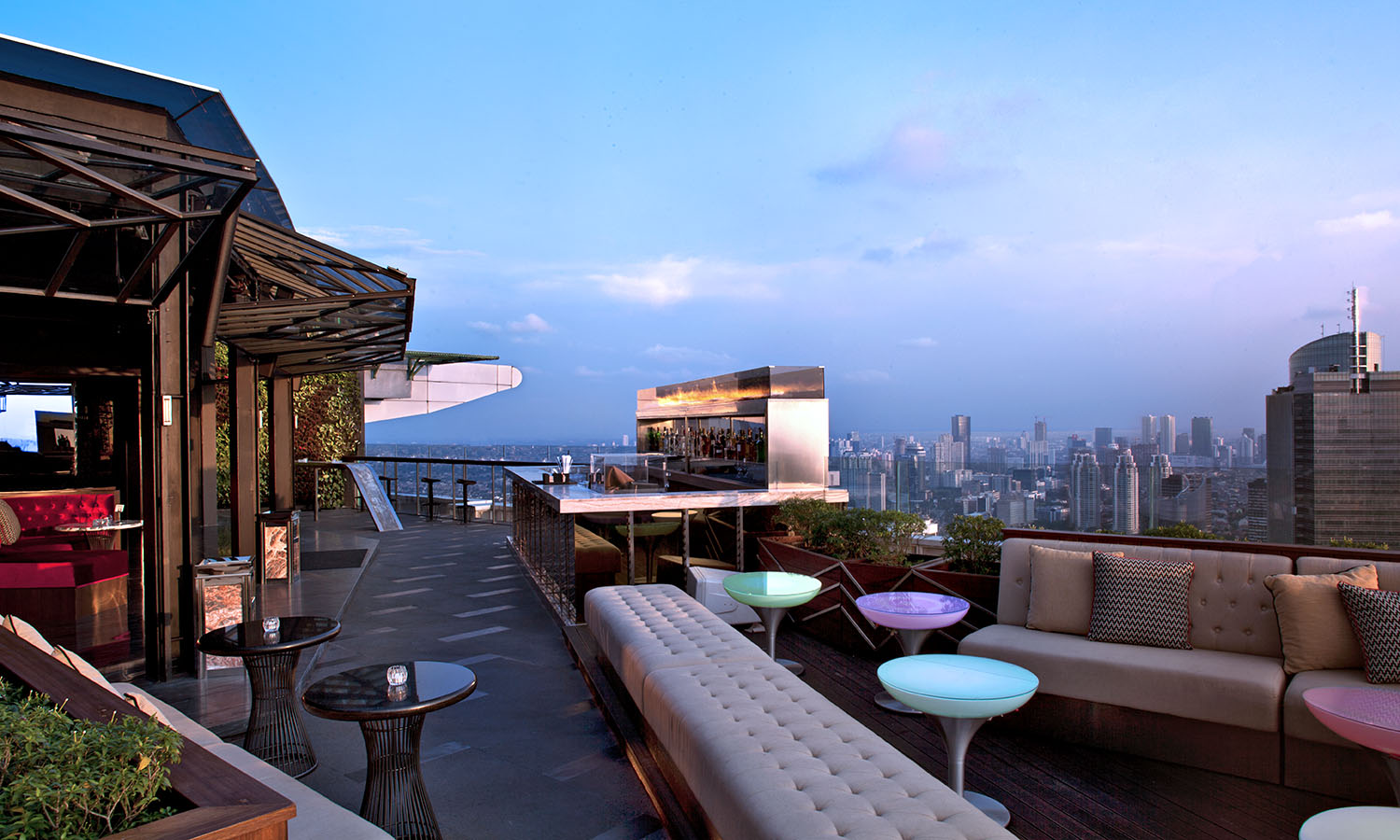

Located on the 49th floor of the Altitude skyscraper, Cloud Lounge has a vantage point unlike any other, with sweeping views across the city. Hold a gathering in one of five ‘living rooms’ that re-create the cosy atmosphere of a private home, or simply relax in the lounge bar and enjoy a cocktail as the sun sets over Jakarta’s skyline.
Feast on Crispy Skin Pigeon
Hate pigeons? You’re not alone. Shooing them away from public squares may give you a sense of satisfaction, but the Chinese enjoy an even more permanent way of banishing these pesky creatures – they eat them. Visit markets around Guangzhou and you’ll see birds plucked and preened for sale, but for some of the city’s best pigeon head to Shen Ji restaurant, which sells up to 500 birds a day.
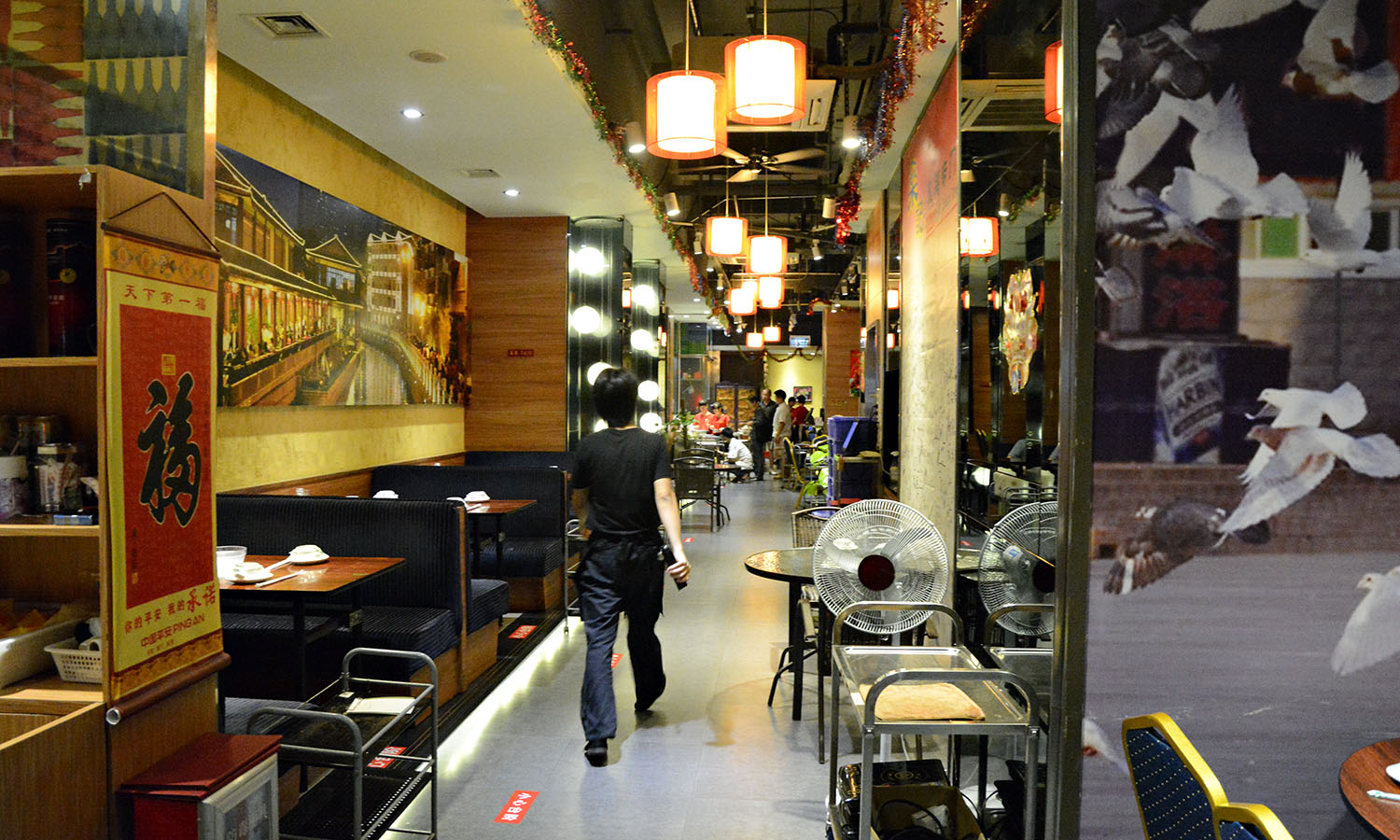

Pass the painted flock at the entrance and settle into the back room with mountains etched on the walls and framed photos of cooked birds gazing at diners with glazed eyes. Choose from an array of flavoured pigeons, including tea and ginger, and squab persevered in bean curd. However, it’s the roasted variety – dished up hot with crispy skin and tender meat – that’s the clear winner. Each bird arrives with its head cocked between a body cleaved in two, ready to be set upon by chopsticks or fingers. Order yourself side of crunchy cucumber cooked with fragrant sesame oil, garlic and chilli and wash it all down with a beer. Revenge has never tasted so surprisingly sweet.
North Korea
Despite all the propaganda and rumours surrounding the Democratic People’s Republic, North Korea is one of the most fascinating travel experiences you could have and is certainly not out of reach. At the moment about 100,000 people a year are landing north of the DMZ and Kim Jong-un wants that number to reach two million by the year 2020. Rarely is an average tourist denied a visa and rarer still do they regret taking the opportunity to go.
Of course, North Korea is by no means your standard holiday destination, and independent travel is not an option. You’ll be escorted by government guides, won’t get much freedom outside of your hotel and there will be strict rules about what you can and can’t photograph. What you will get the opportunity to do, however, depending on which tour you’re on, is view the UNESCO-nominated landscape of Mt Kumgang and its 1200 waterfalls, gawk at the monumental architecture of Pyongyang, visit the Demilitarized Zone between North and South Korea and, more than all that, get a first-hand insight into a culture and country barely touched by the western world.
Powder to the People
Making our way up the mountain in the dead of winter, the usual propaganda signage of party progress adorned the snow-covered hills as we passed old-world farming villages in sub-zero temperatures.
The inaugural North Korean ski season was met with scepticism in the West, partly because sanctions prohibited a Swiss manufacturer from exporting ski lifts to the rogue state. But within North Korea, the ski resort reflected the advances the country was making under its new leader, with Masikryong becoming synonymous with progress and national pride.
In the Democratic People’s Republic of Korea achievement is often measured by how ahead of schedule projects are completed. Throughout our tour of the resort, local guides proudly boasted that the entire place was constructed in just 10 months. Inside the hotel you could still smell the plaster setting – the army likely worked overtime to have the resort built at what has been dubbed ‘Masikryong speed’.
At the pool and sauna we were presented with baby-blue speedos to wear in the steam rooms alongside perplexed elderly Korean women. Symbolic of the centralised production of clothing, every swimmer wore one of two styles of swimsuit. The hotel also had a rare resource – internet, available in the business centre if you don’t mind someone beside you taking notes of your searches. North Korea has the lowest internet connectivity in the world, but the bandwidth on the isolated mountain was surprisingly reliable.
After squeezing my feet into snowboard bindings two sizes too small, I hit the slopes. Masikryong is an ambitious attempt to attract overseas tourists, but the only foreigner I encountered was an Austrian ski instructor. Granted, he spoke highly of the overall standard of the nine ski runs. The West has portrayed Masikryong as a plaything of the country’s elite, built at the expense of the broader, impoverished population. Yet, from what I saw on the mountain, the rookie Korean skiers falling over each other were all with work units, most likely granted the trip as a reward for achieving production targets.
Music looms large in North Korean society. In Pyongyang, revolutionary tunes blast from street speakers and mobile vans, waking workers through a centralised alarm clock. Across Masikryong, the same music can be heard, reminding an emerging generation of skiers to think of the Workers’ Party of Korea and its leader while having fun on the mountain.
The placement of music along each ski run is precise and strategic. Only as our chairlift started climbing the mountain did the triumphant patriotic hymns begin to fade, but the reprieve was short lived. Once over the hill, speakers stuck to every few towers ensured the glorious revolutionary anthems kept us company for the entire 45-minute journey to the summit.
During the ascent, I learnt that the lifts dangling precariously from the slopes were acquired second-hand from China, bypassing trade sanctions. As we neared the summit, the view faded to white and I began to wonder whether safety standards had been compromised for the sake of Masikryong speed. Fortunately, a local bottle of alcoholic ginseng tonic shared with our Korean friends eased my anxiety.
At night the hotel was deserted until we chanced upon a room full of young soldiers, belting out revolutionary hits on a karaoke machine. Their mood was festive and they warmly insisted we drink with them. One of the soldiers was fluent in English and spoke sincerely of his gratitude for Kim Jong-un who, in his eyes, had worked tirelessly to gift Masikryong to the Korean people.
As the beer and soju flowed, the soldiers urged us to sing, dance and form a conga line with them. They pushed us onto the stage and demanded we sing an English song for them. With no English songs available, I was forced to eke out an a cappella rendition of ‘Moon River’, which was met with the raised eyebrows it deserved.
Suddenly, the soldiers marched out as one and we were left in the bar with a female singing troupe who turned out to be members of the Moranbong Band (North Korea’s first all-girl super group hand-picked by Kim Jong-un). Also at the bar was a casually dressed fellow who must have been someone significant, given he was permitted to drink with us. My assumptions were confirmed by the presence of a figure sitting across the room, watching us and smoking in the shadows as we chatted about life in the DPRK and toasted its new ski resort.
The following day as we departed Masikryong, we encountered dozens of farmers on the road using hand tools to uncrack the frozen highway. In the other direction a Mercedes Benz beeped its horn for the road workers to disperse as it ascended the mountain at Masikryong speed.
Try Vietnamese Pizza
Known by the locals as the go-to hang out after university classes, this little hole-in-the wall specialises in Bánh Tráng – also known as Vietnamese pizza. A light meal ideal for sharing, Bánh Tráng consists of crispy rice paper covered in a variety of toppings, like meat, egg, garlic and herbs – depending on what you choose – or unintentionally order.


Each pizza is fried in a hefty dollop of oil, so while not the healthiest meal, eating is a delight to the senses and Bánh Tráng is the perfect snack to end your day on. The restaurant inside is basic, with cracks lining the pastel coloured walls, and the seating is rudimentary – but within this small restaurant lies the heart and soul of Vietnam; good food and good company.
 (
(


